You are here: Invasive Weeds: A Barrier To Development
What is an invasive weed?
• Generally a non-native plant, introduced as a result of trade, accident or botanical curiosity.
• They spread successfully with or without human intervention due to a lack of competition from native species.
• They can transform ecosystems, causing a variety of problems that seriously threaten native and endangered species.
• Some cause public health issues and due to extensive legislation, economic development can be seriously impacted.
Barrier to development – legislation
• The Wildlife and Countryside Act 1981 provides the primary control on the release of non-native species into the wild in Great Britain.
• It is an offence under Section 14(2) of the Act to “plant or otherwise cause to grow in the wild” any plants listed in Schedule 9, Part II. This act is currently being revised and it is anticipated that further plants will be
added to this list in the near future.
• Stricter enforcement provisions for wildlife offences were introduced under the Countryside and Rights of Way Act 2000.
• There are 10 other Acts that legislate against non-native species.
Barrier to development – other reasons
• Construction work should not commence where they are present due to potential to cause damage to hard structures and public health issues.
• A herbicide solution which is a cost effective and sustainable solution can take 1 to 3 years to implement.
• Last minute eradication can involve prohibitive expense of removal to landfill.
• Corporate environmental responsibility.
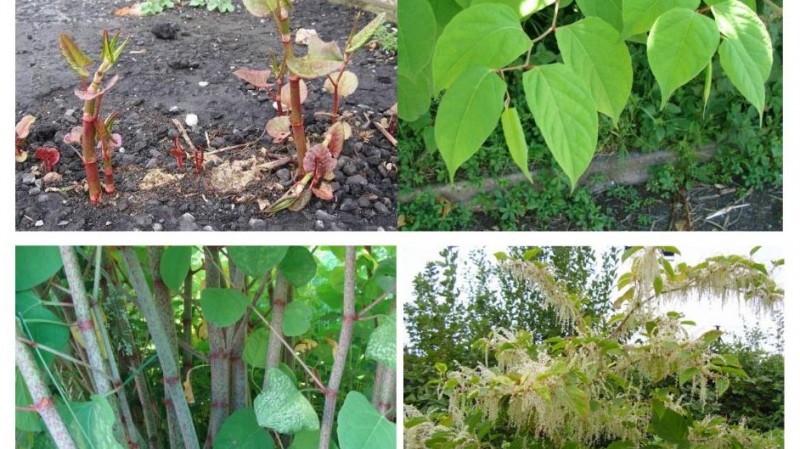
Identification of Japanese Knotweed
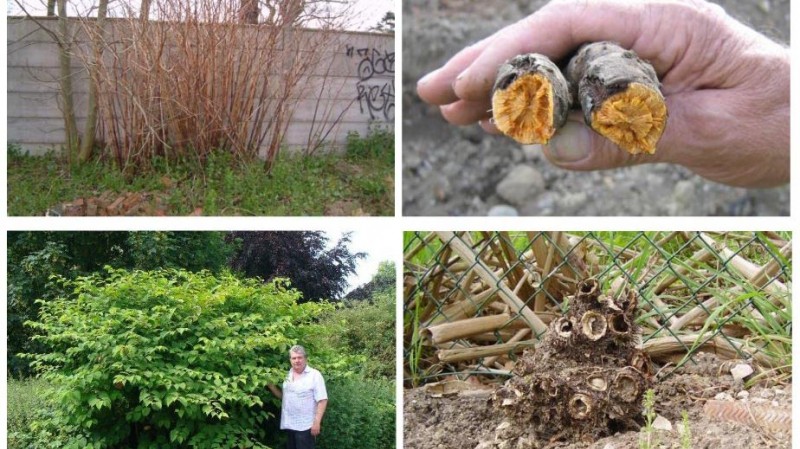
Further Examples of Japanese Knotweed
Japanese knotweed (Fallopia japonica) - why eradicate?
• Legislative responsibility.
• Prevents native seeds from germinating and forms a monoculture, adversely affecting biodiversity and displacing fauna.
• Successful at propagating – we estimate the area of developable brownfield land affected to be approx 800 hectares.
• In 1995, The Environment Agency estimated that the cost to eradicate JK from the UK could be as much as £1.56bn.
• It can cause extensive damage to hard structures.
• Stands can increase by at least 10% in area each year.
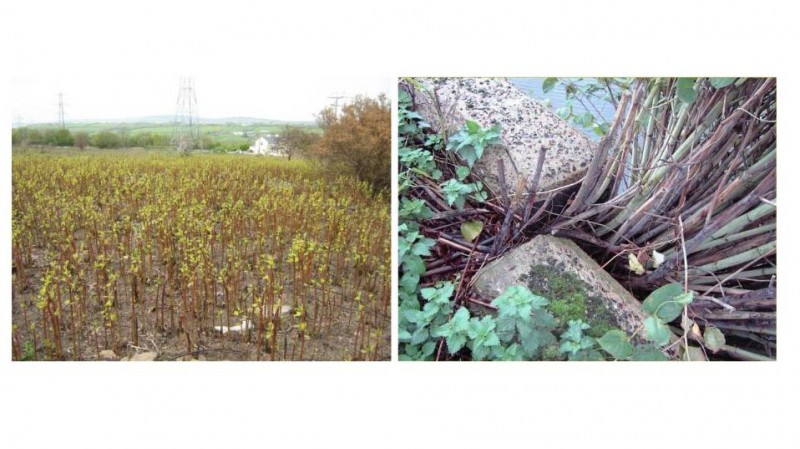
Japanese knotweed – management strategies
• A strategy can be developed for all sites.
• Sites need to be assessed for water courses, existing hard structures, utilities such as gas mains, roads and trees.
• Strategies could include using herbicides, mechanical equipment or a combination of both.
• Development timescales impact the type of strategy employed and the cost of eradication.
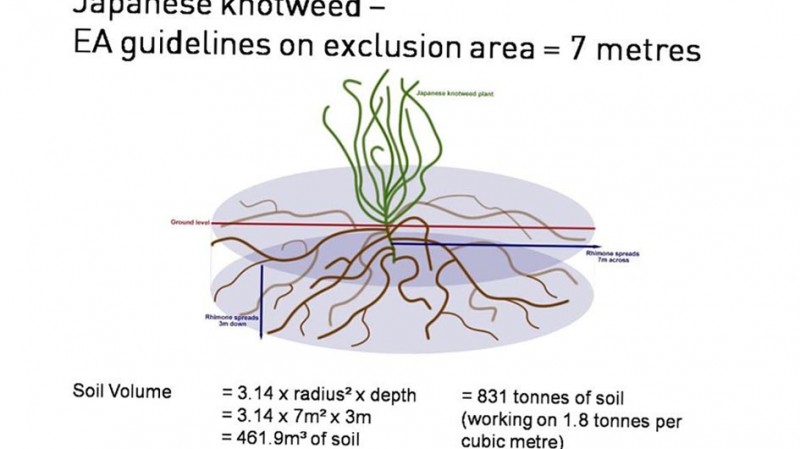
Japanese knotweed - herbicide strategy benefits
• Normally lower cost.
• Treatment in situ.
• Overcomes boundary issues.
• May qualify for land remediation tax relief.
• Carbon emissions minimal.
Japanese knotweed - mechanical methods – excavation and removal to landfill
• Common practice until recently.
• Environment Agency guidelines meant vast amounts of clean soil were taken to landfill.
• A method for monitoring the dig was developed so that reduced quantities of soil went with rhizomes.
• Still appropriate for small areas of infestation where a quick fix is needed.
• Disposal at landfill is unsustainable, expensive, landfill tax exemption now withdrawn and is usually unnecessary.
Japanese knotweed - mechanical methods – environmental cost
Soil Volume = 3.14 x radius² x depth
= 3.14 x 7m² x 3m
= 461.9m³ of soil
= 831 tonnes of soil (working on 1.8 tonnes per cubic metre)
• This example is taken from the EA’s advice on exclusion areas.
• Classed as controlled waste.
• Carbon footprint of 17t rigid diesel HGV is 1.119 Kg/CO2 per km. 831.42 tonnes of soil would fill 49 x 17t HGVs.
The above example of a single stand of knotweed having to travel 50 km to landfill would emit 2,736 Kg/CO2 into the atmosphere (ref: 2008 guidelines to Defras GHG Conversion Factors)
Japanese knotweed- mechanical methods – on site burial and cell encapsulation
• Alternative disposal to removal to landfill after excavation.
• Requires sufficient space on site.
• Can either bury to a depth of 5 metres and cover with membrane or encapsulate in membrane to a depth of 2 metres.
• Works with phased developments.
• Restricts future development possibilities.
Japanese knotweed - research and development - CABI
• CABI Bioscience is planning to introduce a phsyllid from Asia which will control the spread of Japanese knotweed.
• Will help to reduce spread of knotweed in the wild.
• Won’t be enough to deal with legislative responsibilities of landowners and developers because this is not designed to eradicate.
• Concerns that the phsyllid will mutate to damage native species – field trials now authorised and about to commence
Japanese knotweed - research and development – TCM
• Set up to improve efficiency of Japanese knotweed eradication and partly funded by the government through a KTP.
• Improvement on WDA rhizome viability testing method with 3 new types of test, including an on site test.
• Investigation into the possible effects that massive overdosing of herbicides used for stem injection might have on the environment.
• Ongoing research into the physiology of the plant to minimise herbicide doses.
Other invasive weeds
• Whereas Japanese knotweed only spreads via propagation of plant fragments, most other invasive weeds propagate via seed dispersal, although many use both methods.
• Seed banks can be formed where seeds germinate at different rates, meaning that new plants will develop over a number of years after flowering has taken place to aid species survival.
• Distribution of seeds can be via air, flooding, site disturbance and animals or birds.
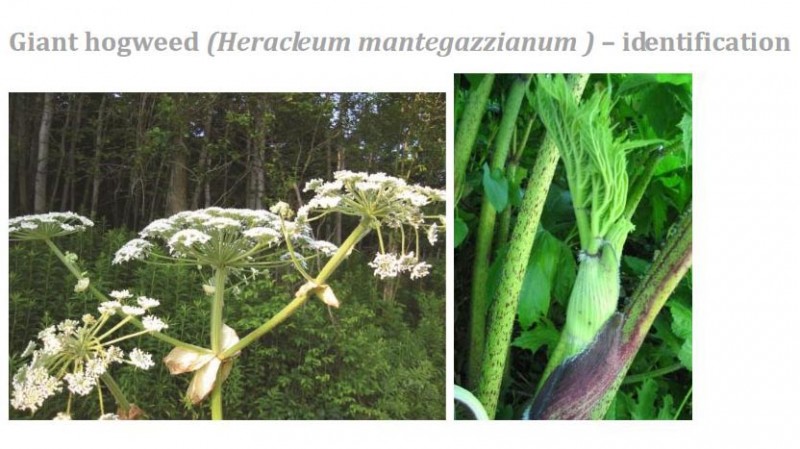
Giant Hogweed Identification
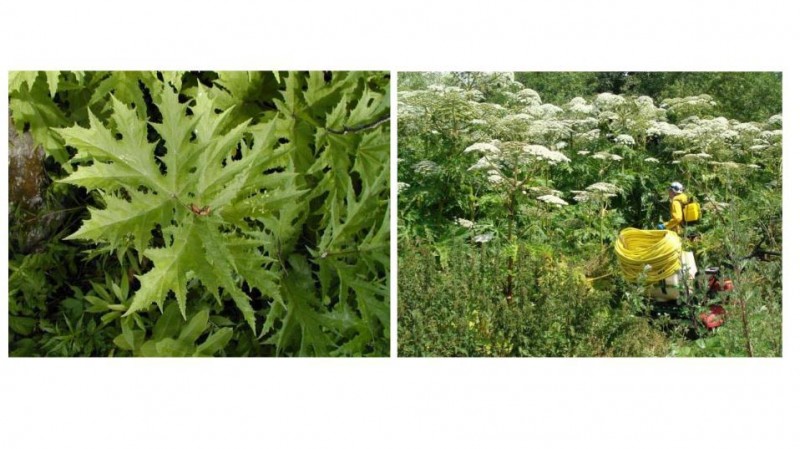
Further examples of Giant Hogweed
Giant hogweed (Heracleum mantegazzianum ) – why eradicate?
• Legislative responsibility.
• Foliage creates a dense canopy over surrounding land, smothering native flora and seriously affecting biodiversity.
• Giant hogweed thrives beside watercourses, causing erosion of riverbanks.
• On contact with the skin, causes photodermatisis and can cause blindness from the chemical, furanocoumarin.
Giant hogweed – herbicide control
• Different types of herbicide can be used for different circumstances.
• Aquatic approved chemicals the only option beside watercourses.
• On other sites, a residual herbicide could be applied to stop the seed bank from germinating but the site must remain undisturbed for 2 to 3 years.
Giant hogweed – mechanical control
• Giant hogweed has a tap route which if severed at a depth of over 10cm below ground, will mean that the plant will die.
• Soil scrape up to a depth of 500 mm will remove the seed bank.
• Disposal could be to landfill or via burial as discussed with Japanese knotweed.
• Environment Agency classes giant hogweed contaminated material as controlled waste.
Other invasive weeds – what’s next?
• There are many other invasive weeds already proscribed under legislation such as ragwort, docks, thistles etc.
• Can be due to their effect on agriculture, livestock or biodiversity.
• Review of the Wildlife and Countryside Act Schedule 9 wants to list even more.
Review of the Wildlife & Countryside Act Schedule 9
• Reviewed by DEFRA through Consultation which finished January 2009.
• Respondents asked for opinion on list of plants suggested for inclusion.
• The list was drawn up by the Non Native Species Secretariat – relatively new Government body (2004) and the Joint Nature Conservation Committee.
• Respondents also asked to suggest additional plants if deemed appropriate.
How WILD is "In the Wild"?
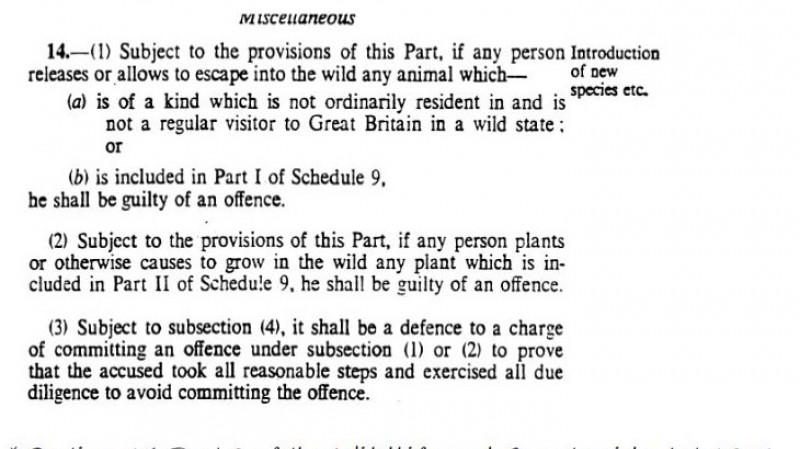
Section 14 Part 2 of the Wildlife and Countryside Act 1981
Statement to clarify ‘In the Wild’
Source: Government Response to the Review of Schedule 9 to the Wildlife and Countryside Act 1981
• Causing to grow in the wild?
• 23. We would expect that where plants listed in Schedule 9 are grown inprivate gardens, amenity areas etc, reasonable measures will be taken to confine them to the cultivated area so as to prevent their spreading to the wider environment and beyond the landowner's control. It is our view that any failure to do so, which in turn results in the plant spreading to the wild, could be considered as “causing to grow in the wild” and as such would constitute an offence. If an individual does not have sufficient ability or the resources to manage a species so as to prevent its spreading to the wild, thereby exposing him or herself to the risk of committing an offence, he/she should seriously consider whether planting a Schedule 9 species is appropriate.
• 24. Additionally, negligent or reckless behaviour, such as inappropriate disposal of garden waste where this results in a Schedule 9 species becoming established in the wild would also constitute an offence.
Conclusion – what to look for when engaging specialist weed management
• Survey for weeds on your site at the earliest opportunity – engage a specialist if identification is in any doubt.
• Ask for a GIS drawing of invasive weeds on your site.
• Make sure their company is Amenity Assured and has robust environmental policies.
• Make sure they can demonstrate successful case histories with references for the type of work you want them to undertake.
• Insist on fixed costs and a fixed timescale with an agreed reporting procedure.
• Make sure they provide full warranty for eradication works and that it is
backed by comprehensive insurance.
Alison Downer
Thurlow Countryside Management Ltd
01440 760 170
07967 832 025
If you need to find a local expert to help with Invasive Weeds or other Ecological Issues, simply click on the links below to get contact details for experts in your local area
Invasive weeds report
If you are concerned that you may have Japanese Knotweed, or other nuisance plants.
Ecological Surveys
A survey of the environment for wildlife that may affect any building or development
Arboricultural Surveys
To assess any impact of trees growing near to properties
Garden Design
If you are considering improving your garden
Land and Topographical Surveys
I am looking for a Land Surveyor
Ground Survey (soil analysis)
Find local Experts to carry out a Ground Survey